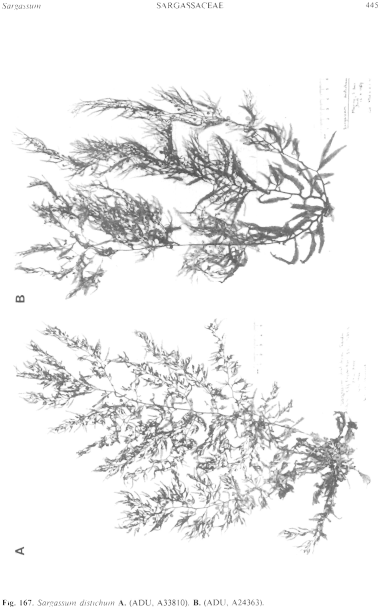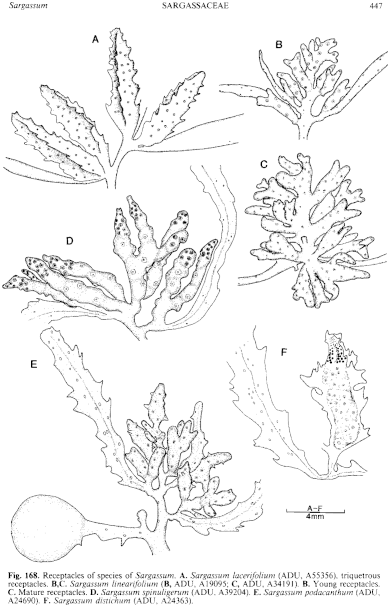|
|
|
|
|
|||||||||||
|
Electronic Flora of South Australia Species Fact Sheet
Phylum Phaeophyta – Order Fucales – Family Sargassaceae
Selected citations: J. Agardh 1848: 348. De Toni 1895: 119.
Synonyms
Sargassum aetnulum Sonder 1853: 672. Non Setchell 1935: 10.
Sargassum cristatum J. Agardh 1889: 84, pl. 25 figs 18–20. De Toni 1895: 44. Lucas 1936: 67.
Thallus (Fig. 167 ) light to medium brown, 10–50 cm long, with a simple stipe 0.5–4 cm long, terete, 1–3 mm in diameter, with rounded branch residues, bearing apically and radially 1–3 primary branches. Holdfast discoid-conical, 4–12 mm across, with 1 (–2) stipes; epilithic. Primary branches 10–50 cm long, axes slightly compressed below, terete to angular above, without spines, alternately distichously branched below with marginal laterals, radially branched above. Laterals (lower) 2–5.5 cm long, 3–6 mm broad (Fig. 167B), simple, linear lanceolate, serrate, apices acute, costate to just below the apex, with prominent scattered cryptostomata, grading to upper laterals of similar form but 0.5–4 (–5) cm long and 2–4 mm broad. Vesicles axillary, subspherical, 2–3 (–4) mm in diameter, with a slender, terete to slightly compressed, petiole (occasionally serrate), mutic or with a terminal leaflet.
Reproduction: Thalli monoecious. Receptacles (Fig. 168F) bisexual, simple or rarely branched, compressed, 2–5 (–7) mm long and 1.5–3 mm broad, with a central, swollen, fertile region and winged, coarsely serrate, lateral margins, occasionally with triquetrous wings near the receptacle apex; occasional receptacles terminate in a leaflet, with scattered ostioles. Conceptacles normally unisexual; oogonia sessile, ovoid, 150–310 µ long and 110–250 µm in diameter, very few per conceptacle; antheridia sessile or on short, branched, paraphyses, ovoid, 16–24 Aim long and 10–14 µm in diameter.
Type from W. Aust. (Preiss); holotype in MEL, 1550992.
Selected specimens: Champion Bay, W. Aust. (Gale; Herb. Sonder, MEL). Yanchep, W. Aust., drift ( Womersley, 22.ix.1979; ADU, A51258). Mandurah, W. Aust., drift (Oberlander, 21.i.1961; ADU, A24712). Frenchman Bay, Albany, W. Aust., drift (Parsons, 18.xi.1968; ADU, A33235). Egg I., Isles of St Francis, S. Aust., 35 m deep (Shepherd, 7.i.1971; ADU, A46402). Venus Bay, S. Aust., drift (Womersley, 12.ii.1954; ADU, A19488). Tiparra reef, Spencer Gulf, S. Aust., 5–6 m deep (Shepherd, 31.x.1970; ADU, A37638). Investigator Strait, S. Aust., 34 m deep, 35°27'S, 137°17'E (Watson, 20.i.1971; ADU, A39205). Troubridge I., S. Aust., 23 m deep (Shepherd, 4.ii.1969; ADU, A33810). Marino, S. Aust., drift (Womersley, 12.x.1959; ADU, A24363). Hallett Cove, S. Aust., drift (Womersley, 11.xii.1960; ADU, A24686). Port Noarlunga, S. Aust., drift ( Womersley, 30.xii.1975; ADU, A47026). Emu Bay, Kangaroo I., S. Aust., drift ( Womersley, 10.i.1946; ADU, A3375). Pennington Bay, Kangaroo I., S. Aust., drift (Womersley, 25.xii.1960; ADU, A24695). Port Phillip Heads, Vic. (Wilson, 24.ii.1894; MEL, 688543).
Distribution: From Champion Bay, W. Aust., around southern Australia to Port Phillip, Vic.
Taxonomic notes: Sargassum distichum is characterised in particular by the receptacles, with their swollen, fertile, central region and marginal, serrate, membranous wings, varying from largely apical in young receptacles to the length of the receptacle in older ones. It is essentially a deep water species.
The type descriptions and the types of S. aemulum Sonder (from Holdfast Bay, S. Aust.; holotype in MEL, 1550993, isotype 687510), and of S. cristatum J. Agardh (lectotype from Port Phillip, Vic.; in Herb. Agardh, LD, 2368) agree well with S. distichum. Sonder (1871, p. 40) recorded S. aetnulum from the Gulf of Carpentaria and from Cape Yorke, Qld, but these specimens in MEL are probably S. flavicans (Mertens) C. Agardh.
Nomina dubia
Sargassum ensifolium (C. Agardh) J. Agardh 1848: 302; 1872: 69; 1889: 73, pl. 22 figs 16–20? (Cystoseira ensifolia C. Agardh 1824: 288).
Type from "New Holland", in Herb. Agardh, LD, 2170.
The type specimen consists only of the basal part, and while it may be the same as S. .fallax the absence of receptacles means that it is not possible to characterise S. ensifolium and the name is therefore regarded as a nomen dubium and rejected. The references of J. Agardh referring to receptacles are based on other specimens in Herb. Agardh which are not associated with basal parts.
Sargassum laevigatum J. Agardh 1889: 67, pl. 19 figs 11–16, from "Tasmania and N.S.W.", is best lectotypified by one of two Meredith specimens from Orford, Tas. (Herb. Agardh, LD, 2057, 2058). Both specimens (as also those of Gunn from Tasmania) are sterile and cannot be identified; they may possibly be S. vestitum, but the name is regarded as a nomen dubium and rejected.
Sargassum leptopodum J. Agardh 1889: 115, pl. 30 figs 8–12, is based on plants from southern Australia (Mueller). The type is in Herb. Agardh, LD, lectotype 3114, and a probable isolectotype in MEL, 687515, is labelled "Melbourne". The upper laterals are very slender, comparable to those of S. linearifolium, but the receptacles are probably juvenile.
The species of J. Agardh is predated by S. leptopodum Sonder (1871, p. 44) from Rockingham Bay, Qld, an apparently distinct species, so J. Agardh's name is invalid.
3. CHRYSOPHYTA
References:
AGARDH, C.A. (1824). Systema Algarum. (Lund.)
AGARDH, J.G. (1848). Species, Genera et Ordines Algarum. Vol. 1. (Gleerup: Lund.)
AGARDH, J.G. (1889). Species Sargassorum Australiae. K. Svenska Vetenskapsakad. Handl. 23(3), 1–133, Plates 1–31.
DE TONI, G.B. (1895). Sylloge Algarum omnium hucusque Cognitarum. Vol. 3. Fucoideae. pp. 1–638. (Padua.)
LUCAS, A.H.S. (1936). The Seaweeds of South Australia. Part 1. Introduction and the Green and Brown Seaweeds. (Govt Printer: Adelaide.)
SETCHELL, W.A. (1935). Hong Kong Seaweeds, IV. Sargassaceae. Hong Kong Nat. Suppl. No. 4: 1–24, Plates 1–17.
SONDER, O.W. (1845). Nova Algarum genera et species, quas in itinere ad oras occidentales Novae Hollandiae, collegit L. Preiss. Bot. Ztg 3, 49–57.
SONDER, O.W. (1848). Algae. In Lehmann, C., Plantae Preissianae. Vol. 2, pp. 161–195. (Hamburg.)
SONDER, O.W. (1853). Plantae Muellerianae. Algae. Linnaea 25, 657–709.
SONDER, O.W. (1871). Die algen des tropischen Australiens. Abh. Nat. Ver. Hamburg 5(2), 33–74, Plates 1–6.
The Marine Benthic Flora of Southern Australia Part II complete list of references.
Publication:
Womersley, H.B.S. (14 December, 1987)
The Marine Benthic Flora of Southern Australia
Part II
©Board of the Botanic Gardens and State Herbarium, Government of South Australia
Illustrations in Womersley Part II, 1997: FIGS 167, 168F.

Figure 167 enlarge
Fig. 167. Sargassum distichum A. (ADU, A33810). B. (ADU, A24363).

Figure 168 enlarge
Fig. 168. Receptacles of species of Sargassum. A. Sargassum lacerifolium (ADU, A55356), triquetrous receptacles. B,C. Sargassum linearifolium (B, ADU, A19095; C, ADU, A34191). B. Young receptacles. C. Mature receptacles. D. Sargassum spinuligerum (ADU, A39204). E. Sargassum podacanthum (ADU, A24690). F. Sargassum distichum (ADU, A24363).

|
Email Contact: State Herbarium of South Australia |

|